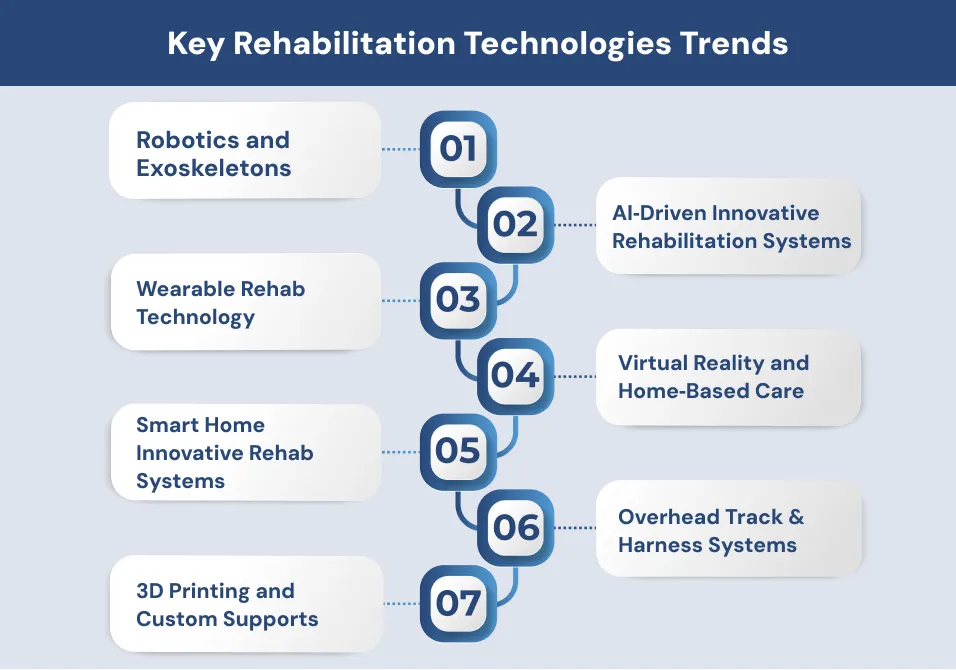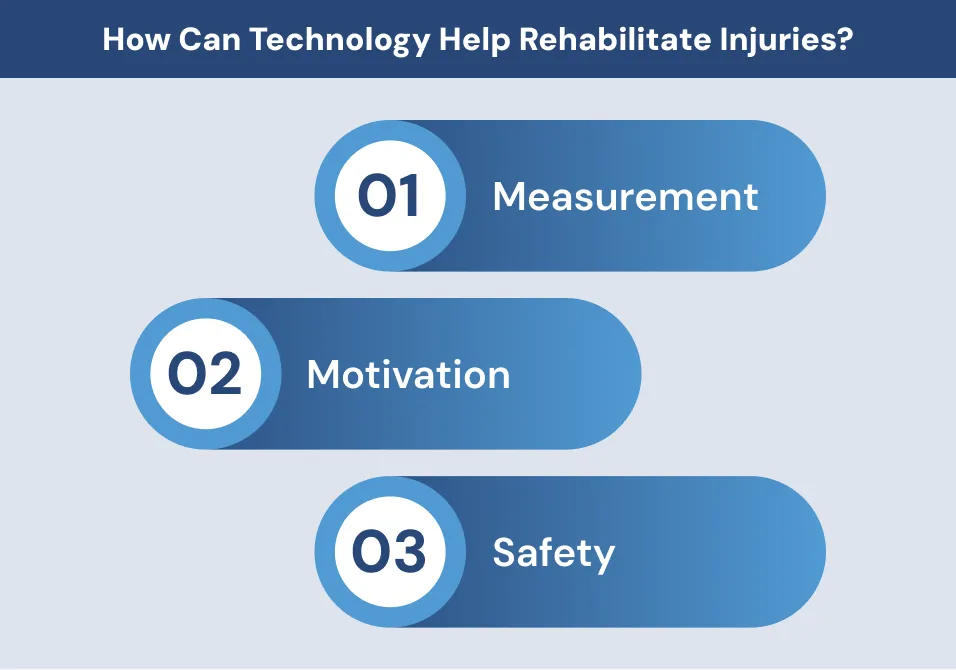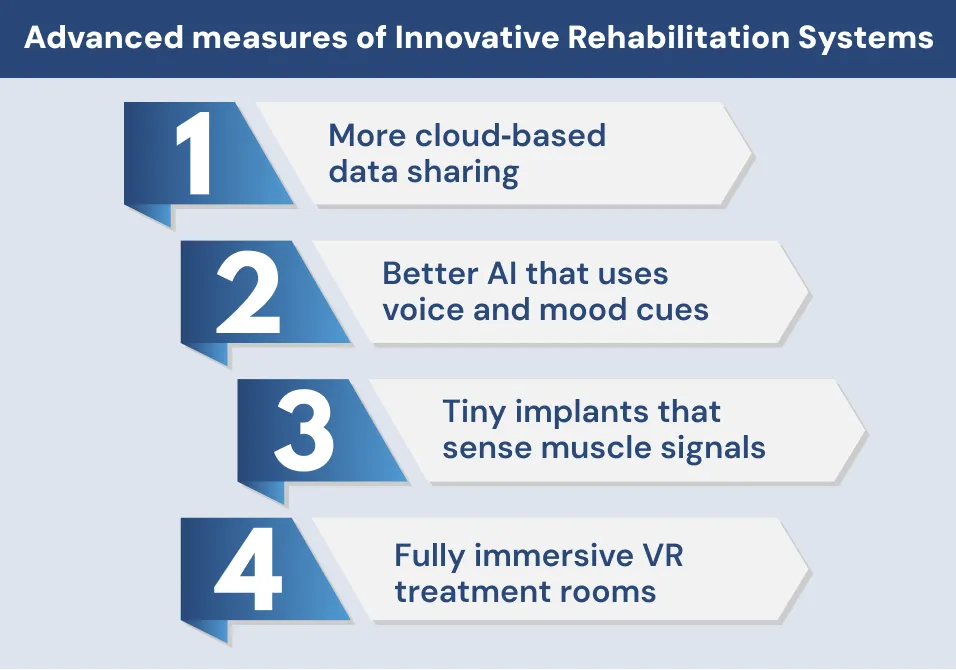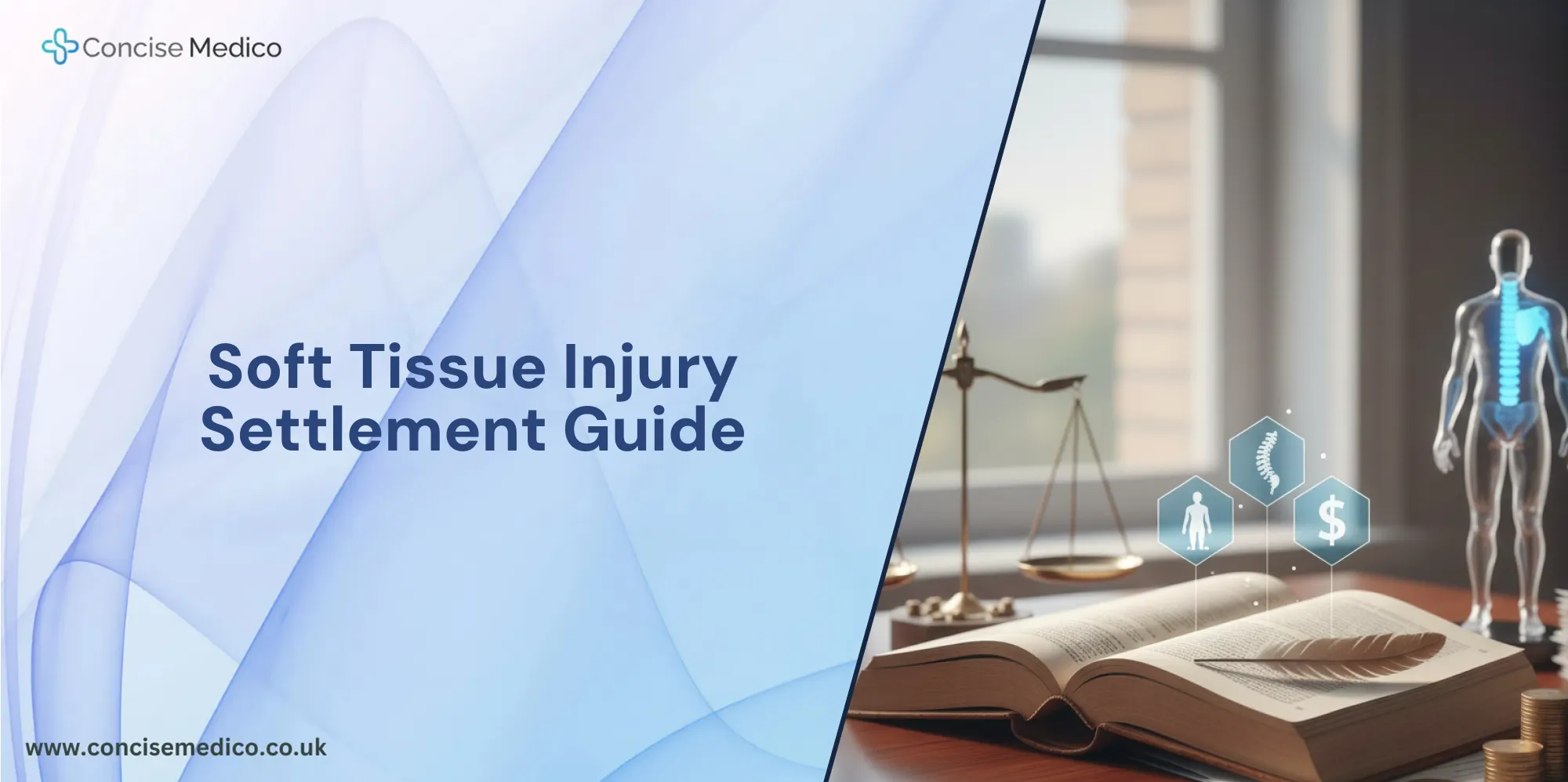TABLE OF CONTENT
- What Is Advanced Rehabilitation Technology?
- Key Rehabilitation Technologies Trends
- How Can Technology Help Rehabilitate Injuries?
- The Future of Innovative Rehabilitation Systems
- Empowering Recovery Through Innovation
- How Concise Medico Helps you?
- FAQs
How Advanced Rehabilitation Technology Is Shaping Recovery in 2025
Rehabilitation methods have changed more quickly than ever. Today, advanced rehabilitation technology offers new hope. From smart robots to data‑driven tools, patients get better care. Emerging mental rehab platforms like Virtual reality games and AI mood trackers, help people rebuild strength and cope with emotions after injury. At the same time, smart exoskeletons and robots support movement and give instant feedback to speed up physical recovery. In the UK, there are over 1.3 million stroke survivors living with long‑term disability. This shows a real need for new tech based therapy. In this post, we explore key rehabilitation technologies and innovative rehabilitation systems in regard with physical injuries. We also explain how can technology help rehabilitate injuries to regain strength.
What Is Advanced Rehabilitation Technology?
Advanced rehabilitation technology means tools that boost physical therapy. This may include:
- Robots that assist movement
- AI systems that plan exercises
- Wearables that track muscle work
- Virtual worlds for practice
- 3D‑printed braces and supports
These tools aid both patients and therapists. They bring data, real‑time feedback, and fun to therapy.
Key Rehabilitation Technologies Trends
1. Robotics and Exoskeletons
Robotics lead the pack. Modern exoskeletons let people stand or walk. They link to sensors on the body. Each step is guided by the device. This cuts errors and risk. Exoskeletons also help movement of arms and hands. Stroke survivors use them to regain grip and reach. It helps in:
- Precise, repeatable motion
- Real‑time progress tracking
- Less strain on therapists
Read more details about Early Rehabilitation Stroke Benefits
2. AI‑Driven Innovative Rehabilitation Systems
AI powers bespoke rehab. It underpins adaptive rehab systems that learn from each session. It empowers innovative rehab systems that learn from each session.
These rehab systems help to:
- Track your motion and effort
- Adjust your plan as you improve
- Predict your pace of recovery

Personalised Plans
AI uses your own data. It sets goals that match your speed. This keeps you safe and on track.
Predictive Analytics
With enough data, AI can say, “This task may take eight weeks to hit this milestone.” This helps rehab teams make treatment plans and set realistic goals.
Know everything about The Future of Robotic Rehabilitation Therapy
3. Wearable Rehab Technology
Wearables have grown smart. These include devices such as smartwatches and fitness trackers. These devices warn users when they push too hard. They help you stay safe. Some wearables pairs sync with apps or Virtual reality gear. This turns dull drills into fun games. Gamified rehab can boost mood and stick‑with‑it power.
Wearable can track:
- Joint angles
- Muscle activity
- Heart rate and exertion levels
“Assistive products help maintain or improve an individual’s functioning related to cognition, communication, hearing, mobility, self-care and vision, thus enabling their health, well-being, inclusion and participation.”
World Health Organization (WHO)
4. Virtual Reality and Home‑Based Care
VR devices take therapy into virtual rooms. Patients wear a headset and do tasks like:
- Reaching for objects
- Balancing on a beam
- Navigating a virtual home
This helps their brain to relearn basic skills. This process is called neuroplasticity. Studies show VR users do more sessions and stick to their plan longer. This shows why assistive technology in rehab matters. It is not a luxury. It is a core part of care.
5. Smart Home Innovative Rehab Systems
Smart homes are now part of innovative rehab. These are designed to ensure safety and comfort for patients. These devices include:
Smart mirrors
Smart mirrors give instant visual feedback of each movement. They guide the patient through tailored exercises for safe mobility.
Voice assistants
These assistants cue exercises. Simple voice commands start or stop routines. They remind you to stretch or rest. This hands‑free support helps maintain consistency.
Motion sensors
They send data to medical experts. Tiny sensors track your range of motion at home. They upload metrics to your care team. Your therapist can tweak your plan based on real data.
Smart homes ensure that you can stay functional at home with the aid of advanced rehabilitation technology. A therapist can monitor and modify your workout from afar. You don’t lose time or momentum.
6. Overhead Track & Harness Systems
This advanced rehabilitation technology uses a ceiling-mounted track and harness to lift patients during exercises. The setup keeps users upright and cuts the risk of falls.
Enhanced Safety
The harness holds patients if they slip or lose balance. This gives them the confidence to try harder movements.
Staff Ease
Caregivers no longer lift by hand, so they save energy. They can spend more time helping patients move correctly.
7. 3D Printing and Custom Supports
3D printed devices are used for improved mobility and smooth recovery of the patients. These custom gears are easily wearable and tailored to their needs. These help to create:
- Braces that fit your body shape
- Orthotics with just the right stiffness
- Prosthetics built to match your style
How Can Technology Help Rehabilitate Injuries?
Technology can help rehabilitate injuries in three main ways:
1. Measurement
It gives hard data on your body’s work. Sensors record each move in detail. Therapists use this data to spot small gains or risks. Clear numbers make the goal‑setting simple.
2. Motivation
Gamified tools make you want to try again. You earn points, badges, or even virtual high‑fives. Tracking successes drives you to hit the next target. Turning therapy into a game keeps you engaged.
3. Safety
Real‑time alerts stop you from over‑doing it. Wearables warn you if you push past safe limits. This cuts the chance of re‑injury. You learn your body’s signals and stay within safe zones.
By using advanced rehabilitation technology, you will get a plan that fits well for you. You can see progress charts which can be shared with your care team.

The Future of Innovative Rehabilitation Systems
Advanced measures in rehab system will add:
More cloud‑based data sharing
Cloud servers will hold exercise logs and sensor data. Teams can view your results from any clinic or home. This step helps to utilise advanced rehabilitation technology across sites without extra hardware.
Better AI that uses voice and mood cues
Future systems will listen to how you speak and even feel. They can sense if you sound tired or stressed. This lets them change your session to match your mood and energy.
Tiny implants that sense muscle signals
Micro devices under the skin will read nerve or muscle activity. They send data to machines that guide your therapy. This level of feedback is a big leap for advanced rehabilitation technology.

Fully immersive VR treatment rooms
These rooms use headsets and motion trackers all around you. You can walk through virtual streets or climb virtual hills. This makes rehab fun and helps your brain relearn tasks in safe settings.
Empowering Recovery Through Innovation
In 2025, advanced rehabilitation technology has opened new doors. From AI plans to VR worlds, patients get more choice and more control. The rise of innovative rehab systems and assistive technology in rehabilitation means rehab is safer, smarter, and more fun.
How Concise Medico Helps you?
At Concise Medico, we lead with the best tools. We aim to help you heal with care that blends technology and human touch. To learn how our rehab experts utilise rehabilitation technologies, rehab technology, and advanced rehabilitation technology reach out to us today. Let us guide you on your path towards complete recovery.
FAQs
How Advanced Rehabilitation Technology Is Shaping Recovery in 2025
Rehabilitation methods have changed more quickly than ever. Today, advanced rehabilitation technology offers new hope. From smart robots to data‑driven tools, patients get better care. Emerging mental rehab platforms like Virtual reality games and AI mood trackers, help people rebuild strength and cope with emotions after injury. At the same time, smart exoskeletons and robots support movement and give instant feedback to speed up physical recovery. In the UK, there are over 1.3 million stroke survivors living with long‑term disability. This shows a real need for new tech based therapy. In this post, we explore key rehabilitation technologies and innovative rehabilitation systems in regard with physical injuries. We also explain how can technology help rehabilitate injuries to regain strength.
What Is Advanced Rehabilitation Technology?
Advanced rehabilitation technology means tools that boost physical therapy. This may include:
- Robots that assist movement
- AI systems that plan exercises
- Wearables that track muscle work
- Virtual worlds for practice
- 3D‑printed braces and supports
These tools aid both patients and therapists. They bring data, real‑time feedback, and fun to therapy.
Key Rehabilitation Technologies Trends
1. Robotics and Exoskeletons
Robotics lead the pack. Modern exoskeletons let people stand or walk. They link to sensors on the body. Each step is guided by the device. This cuts errors and risk. Exoskeletons also help movement of arms and hands. Stroke survivors use them to regain grip and reach. It helps in:
- Precise, repeatable motion
- Real‑time progress tracking
- Less strain on therapists
Read more details about Early Rehabilitation Stroke Benefits
2. AI‑Driven Innovative Rehabilitation Systems
AI powers bespoke rehab. It underpins adaptive rehab systems that learn from each session. It empowers innovative rehab systems that learn from each session.
These rehab systems help to:
- Track your motion and effort
- Adjust your plan as you improve
- Predict your pace of recovery

Personalised Plans
AI uses your own data. It sets goals that match your speed. This keeps you safe and on track.
Predictive Analytics
With enough data, AI can say, “This task may take eight weeks to hit this milestone.” This helps rehab teams make treatment plans and set realistic goals.
Know everything about The Future of Robotic Rehabilitation Therapy
3. Wearable Rehab Technology
Wearables have grown smart. These include devices such as smartwatches and fitness trackers. These devices warn users when they push too hard. They help you stay safe. Some wearables pairs sync with apps or Virtual reality gear. This turns dull drills into fun games. Gamified rehab can boost mood and stick‑with‑it power.
Wearable can track:
- Joint angles
- Muscle activity
- Heart rate and exertion levels
“Assistive products help maintain or improve an individual’s functioning related to cognition, communication, hearing, mobility, self-care and vision, thus enabling their health, well-being, inclusion and participation.”
World Health Organization (WHO)
4. Virtual Reality and Home‑Based Care
VR devices take therapy into virtual rooms. Patients wear a headset and do tasks like:
- Reaching for objects
- Balancing on a beam
- Navigating a virtual home
This helps their brain to relearn basic skills. This process is called neuroplasticity. Studies show VR users do more sessions and stick to their plan longer. This shows why assistive technology in rehab matters. It is not a luxury. It is a core part of care.
5. Smart Home Innovative Rehab Systems
Smart homes are now part of innovative rehab. These are designed to ensure safety and comfort for patients. These devices include:
Smart mirrors
Smart mirrors give instant visual feedback of each movement. They guide the patient through tailored exercises for safe mobility.
Voice assistants
These assistants cue exercises. Simple voice commands start or stop routines. They remind you to stretch or rest. This hands‑free support helps maintain consistency.
Motion sensors
They send data to medical experts. Tiny sensors track your range of motion at home. They upload metrics to your care team. Your therapist can tweak your plan based on real data.
Smart homes ensure that you can stay functional at home with the aid of advanced rehabilitation technology. A therapist can monitor and modify your workout from afar. You don’t lose time or momentum.
6. Overhead Track & Harness Systems
This advanced rehabilitation technology uses a ceiling-mounted track and harness to lift patients during exercises. The setup keeps users upright and cuts the risk of falls.
Enhanced Safety
The harness holds patients if they slip or lose balance. This gives them the confidence to try harder movements.
Staff Ease
Caregivers no longer lift by hand, so they save energy. They can spend more time helping patients move correctly.
7. 3D Printing and Custom Supports
3D printed devices are used for improved mobility and smooth recovery of the patients. These custom gears are easily wearable and tailored to their needs. These help to create:
- Braces that fit your body shape
- Orthotics with just the right stiffness
- Prosthetics built to match your style
How Can Technology Help Rehabilitate Injuries?
Technology can help rehabilitate injuries in three main ways:
1. Measurement
It gives hard data on your body’s work. Sensors record each move in detail. Therapists use this data to spot small gains or risks. Clear numbers make the goal‑setting simple.
2. Motivation
Gamified tools make you want to try again. You earn points, badges, or even virtual high‑fives. Tracking successes drives you to hit the next target. Turning therapy into a game keeps you engaged.
3. Safety
Real‑time alerts stop you from over‑doing it. Wearables warn you if you push past safe limits. This cuts the chance of re‑injury. You learn your body’s signals and stay within safe zones.
By using advanced rehabilitation technology, you will get a plan that fits well for you. You can see progress charts which can be shared with your care team.

The Future of Innovative Rehabilitation Systems
Advanced measures in rehab system will add:
More cloud‑based data sharing
Cloud servers will hold exercise logs and sensor data. Teams can view your results from any clinic or home. This step helps to utilise advanced rehabilitation technology across sites without extra hardware.
Better AI that uses voice and mood cues
Future systems will listen to how you speak and even feel. They can sense if you sound tired or stressed. This lets them change your session to match your mood and energy.
Tiny implants that sense muscle signals
Micro devices under the skin will read nerve or muscle activity. They send data to machines that guide your therapy. This level of feedback is a big leap for advanced rehabilitation technology.

Fully immersive VR treatment rooms
These rooms use headsets and motion trackers all around you. You can walk through virtual streets or climb virtual hills. This makes rehab fun and helps your brain relearn tasks in safe settings.
Empowering Recovery Through Innovation
In 2025, advanced rehabilitation technology has opened new doors. From AI plans to VR worlds, patients get more choice and more control. The rise of innovative rehab systems and assistive technology in rehabilitation means rehab is safer, smarter, and more fun.
How Concise Medico Helps you?
At Concise Medico, we lead with the best tools. We aim to help you heal with care that blends technology and human touch. To learn how our rehab experts utilise rehabilitation technologies, rehab technology, and advanced rehabilitation technology reach out to us today. Let us guide you on your path towards complete recovery.




